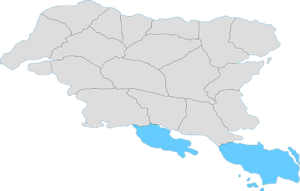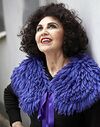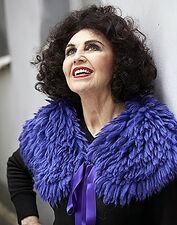Gylian presidential election, 2015
| |||||||||||||||||
| Turnout | 93,5% | ||||||||||||||||
|---|---|---|---|---|---|---|---|---|---|---|---|---|---|---|---|---|---|
| |||||||||||||||||
 | |||||||||||||||||
| |||||||||||||||||
Presidential elections were held in Gylias on 22 January 2015.
Incumbent Laura Varnaþ was re-elected, defeating Union for a New Republic candidate Electra Galanou.
Procedure
The election was held through instant-runoff voting.
Candidates were registered with Elections Gylias in accordance with normal procedures. They could either be nominated by a political party or electoral bloc, civic organisations, or self-nomination as independents.
Candidates
| Candidate | Nominator | Office(s) held | Details | ||
|---|---|---|---|---|---|
| Laura Varnaþ | 
|
Progressive Alliance | City Councillor of Velouria (1992–2002) Regional Councillor for Nerveiík-Iárus-Daláyk (2002–2006) President of Gylias (since 2007) |
Campaigned as the main leftist candidate. | |
| Electra Galanou | 
|
Union for a New Republic | Chief executive of Omicron Group (since 1961) |
Campaigned on promotion of economic nationalism and disability rights. | |
| Helena Bonham | 
|
Liberal Union | None | Campaigned as the main liberal candidate. | |
| Keie Nanei | 
|
Independent | None | Campaigned on a satirical platform. | |
| Amanda Leloup | 
|
OMFLG–ACFEN | Governor of Nezyál (1970–1978) |
Campaigned on promotion of francité. | |
| Victoria Cavallo | 
|
Independent | None | Campaigned on a satirical platform. | |
| Saeni Rotara | 
|
Humanist Party | None | Campaigned on promotion of the arts and culture. | |
Results
| Candidate | Nominator | First count | % | Final count | % | |
|---|---|---|---|---|---|---|
| Laura Varnaþ | PA | 2.681.807 | 16,1% | 7.700.283 | 50,8% | |
| Electra Galanou | UNR | 2.665.149 | 16,0% | 7.457.754 | 49,2% | |
| Helena Bonham | LU | 2.663.484 | 16,0% | |||
| Keie Nanei | Independent | 2.416.957 | 14,5% | |||
| Amanda Leloup | OMFLG–ACFEN | 2.398.634 | 14,4% | |||
| Victoria Cavallo | Independent | 1.832.290 | 11,0% | |||
| Saeni Rotara | HP | 1.798.976 | 10,8% | |||
| Others/write-ins | 199.886 | 1,2% | ||||
| Total | 16.657.183 | 100% | 15.158.037 | 100% | ||
| Registered voters and turnout | 18.178.744 | 93,5% | ||||
Maps
Analysis
After two nail-biter wins in 2007 and 2011, the incumbent Laura Varnaþ entered her last election in a more secure position. However, the large number of candidates led to expectations that the voting would be tight, and speculation who would face Laura in the final round.
The National Bloc did not nominate a candidate after Yseult Roxane Danesh's poor showing in 2011. Instead, the conservative mantle was taken by the Union for a New Republic's candidate Electra Galanou, who had previously finished third in 1986.
A somewhat surprising nomination was Helena Bonham as the Liberal Union's candidate. A well-established, beloved character actress known for her quirky roles, Helena was also the grand-daughter of famed "anarcho-liberal" Violet Bonham, and accepted nomination in part due to an interest in "living up to the family name".
Confounding expectations, Helena ran a serious campaign, marked by erudite speeches that placed her in the liberal socialist tradition of the Free Territories. Arguably her sole concession to her cinematic fame was dressing in deliberately anachronistic Alscian fashions, but this mainly drew comparisons to Gylias' first president, Eiín Dairyn.
Voters also enjoyed a strong line-up of colourful candidates: columnist Keie Nanei (a returning candidate from 2003), comedian Victoria Cavallo (whose signature promise was organising a referendum on making "Arise, Gylians" the national anthem), and writer Saeni Rotara, who sought the Humanist Party nomination due to discomfort with running as an independent.
In the first round, Laura obtained a narrow plurality of 16,1% of first preference votes, and carried the northern regions of Salxar, Makarces, Gacar, and Gerşyr, which had previously gone against her. Electra took second place, overtaking Helena by only 1.665 votes. Helena registered a strong performance despite narrowly missing out advancing to the final round, winning pluralities in Tomes thanks to a sweep of Ðoron and Kaşa, and coming within 0,5% of overtaking Electra in Nerveiík-Iárus-Daláyk.
Keie's fourth place finish and 14,5% of first preference votes represented a 4,3% decline from her 2003 performance, but she still managed to win pluralities in Kausania and Envadra. Amanda trailed only 0,1% behind, and retained pluralities in Nezyál, Herlan, and Aðuna.
Victoria won 11% of first preference votes, coming second in Arxaþ, and Alţira, but not managing to win a regional plurality. Conversely, Saeni finished last, but picked up much of the "non-inscrit left" vote, managing pluralities in Mişeyáke, Sváen, Nauras, and Tandar.
In the final round, Laura generally gained transfers from Helena and Saeni's voters. Keie, Amanda, and Victoria's voters were more unpredictable with their preferences, keeping the contest close. In the end, Laura won by 50,8% of final preferences to Electra's 49,2% — her widest victory margin, but still only some 240.000 votes apart.
On the final map, Laura won majorities in 14 regions compared to Electra's 6, duplicating Anina Bergmann's feat in 2003. Besides her regions, Electra only managed to gain Aðuna from Amanda, Nauras from Saeni, and Envadra from Keie. The rest were all swept by Laura, although most by modest margins. This was the only election in which Laura carried Tandar in the end.




